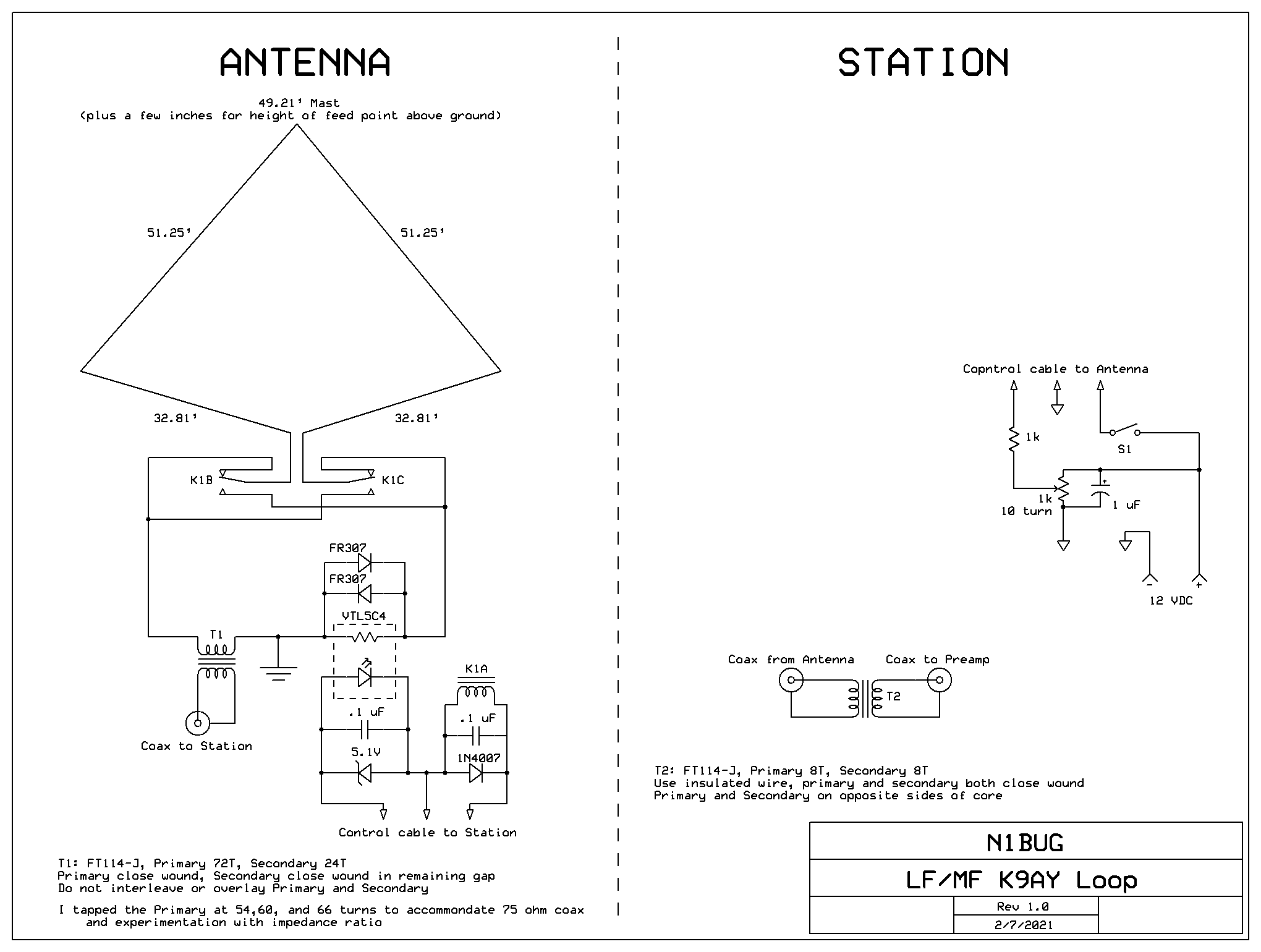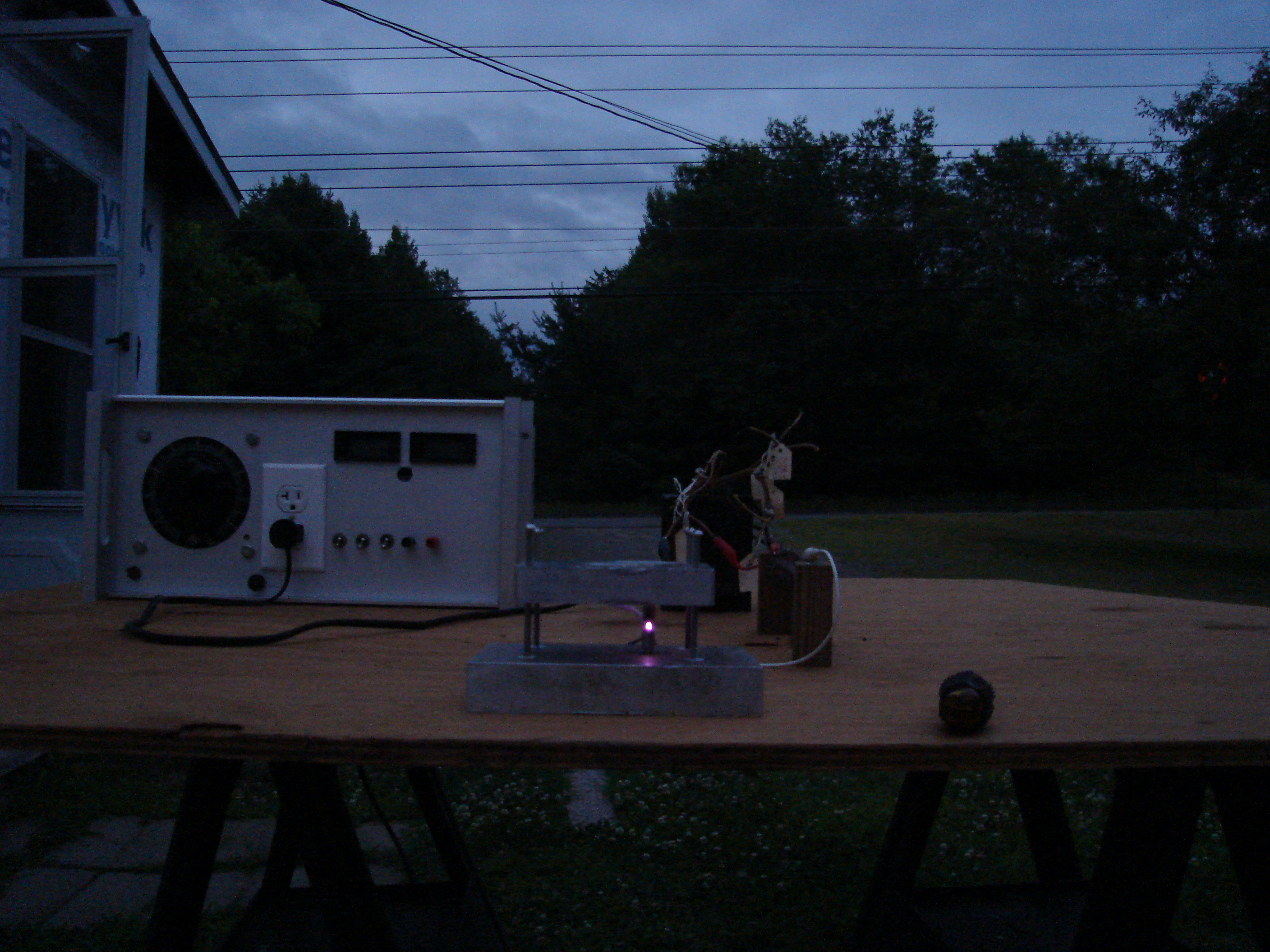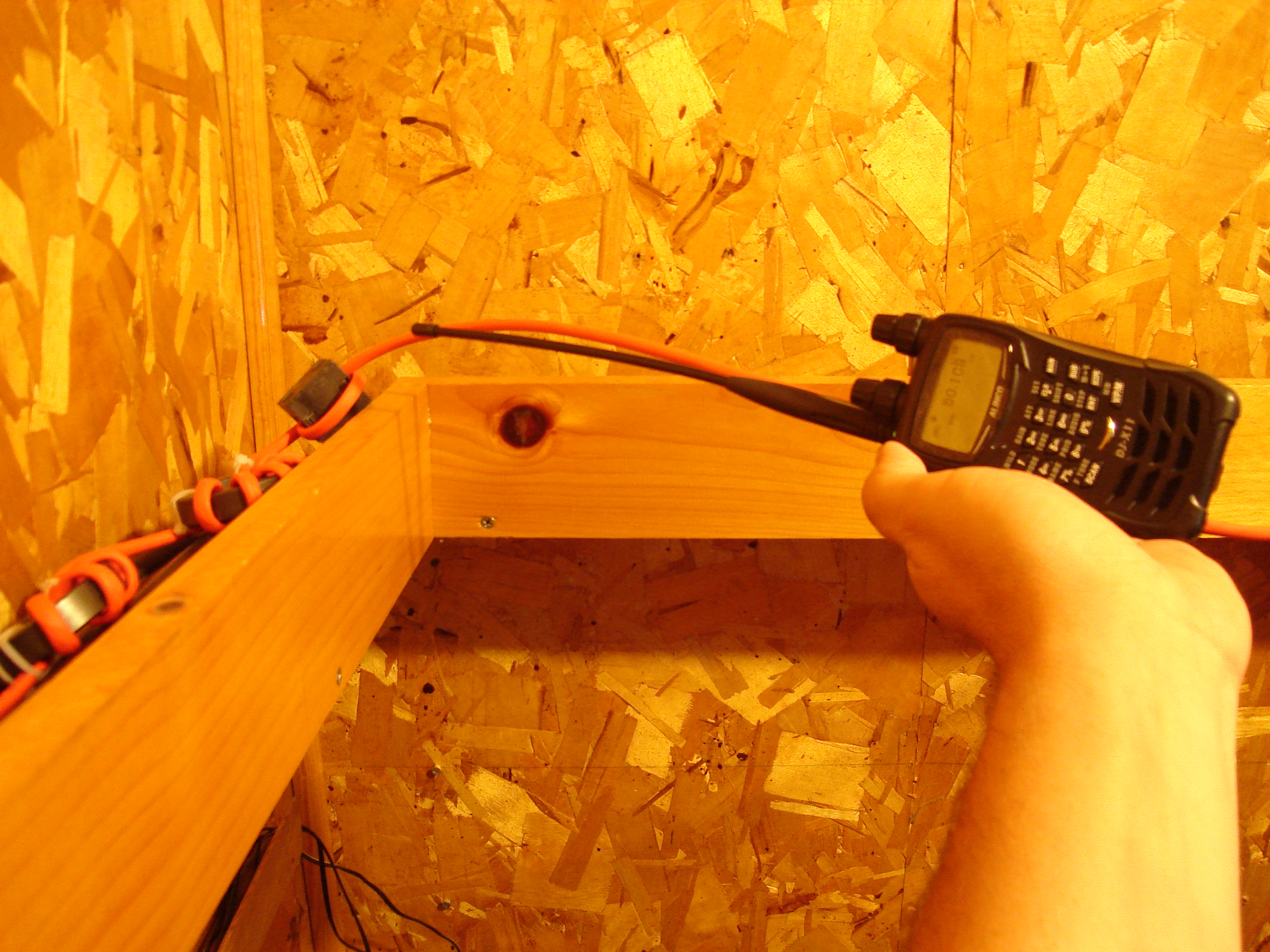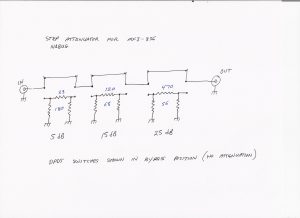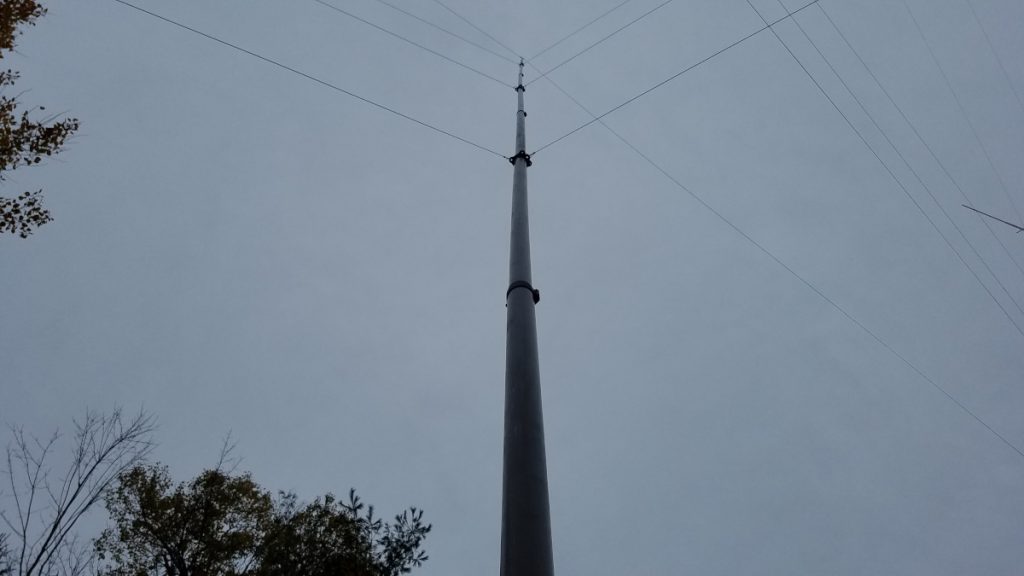
During the late summer and autumn of 2020 I built a K9AY loop, hoping it would help me hear DX on 2200 meters. Computer modeling suggested the minimum size for good front to back ratio and overall pattern would be twice the size of the original 160/80 meter K9AY loop design. This required a 50 foot mast. I chose to use a fiberglass mast to ensure there would be no interaction with the antenna. Since the “gain” of this antenna at 137 kHz is -55 dB, I was worried about common mode noise ingress. In an effort to minimize any such problems, transformer coupling was used at both ends of the coaxial cable feeding the antenna.
Having limited space I was not sure how successful this project would be. The K9AY would have to be located within 50 feet of my 2200 meter transmitting antenna, over the 160/630/2200 meter radial field, no more than 50 feet from one of the towers and just a bit over 100 feet from the other. That is not an ideal environment for a small directional receiving antenna!
The best location, considering other antennas, seemed to be atop a small mound in the back yard. I immediately had misgivings about that, since I knew the origin of that mound. It was what was left after the lawn area was flattened with a bulldozer about 45 years ago. At the time there was an automobile junk yard next door, spilling over onto this property which was owned by the same party. I had no idea what I might find when I tried to dig a hole to put in concrete for the mast footing! In the first several inches, I encountered several strands of old barbed wire. Lovely! Next was a power steering pump and a water pump. At about the two foot level the real challenge presented itself: a buried concrete slab several inches thick, obscuring about two thirds of my hole area, and tilted at a 30 degree angle with respect to horizontal. Oh, great! It took hours of beating on that slab with a heavy steel bar to break it up and continue excavation. Digging a four foot deep hole 18 inches in diameter with nothing more than a spade is always fun, but I got the job done. It has been suggested on several occasions that I am “determined”. I think that is a nice way of calling me stubborn! But it fits.
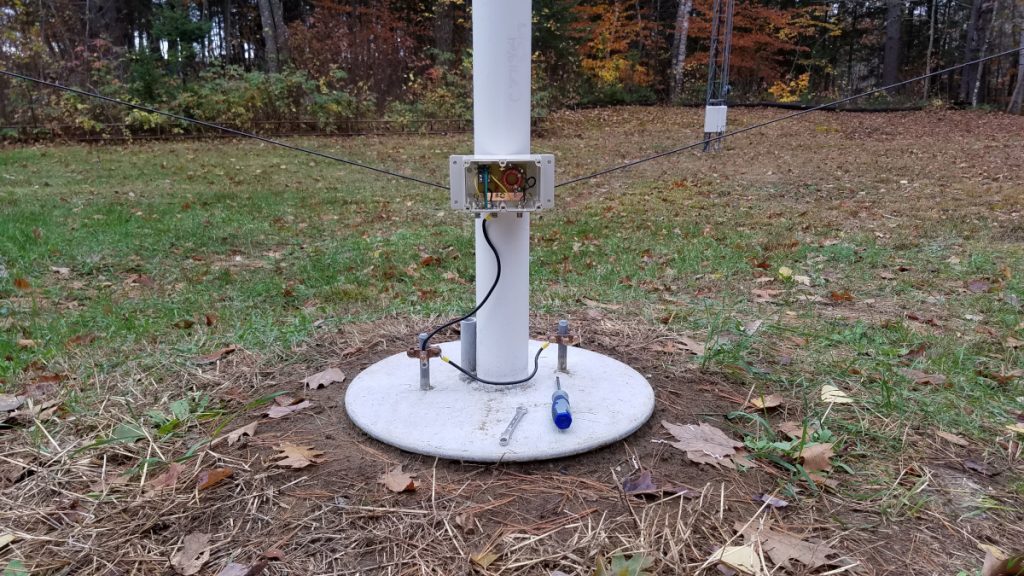
When the antenna became operational, front to back was no better than 3 to 6 dB. Some quick experimentation showed that de-resonating the 2200 meter transmitting antenna improved the situation greatly. With that change I could often see 15 dB front to back but not always. Several methods for de-resonating were tried, but it turns out simply disconnecting the bottom of the loading coil/variometer from the secondary of the toroidal impedance matching transformer is as effective as any other method. I modified my station so that I could do that from the operating position and even have the antenna automatically resonated while transmitting and de-resonated while receiving.
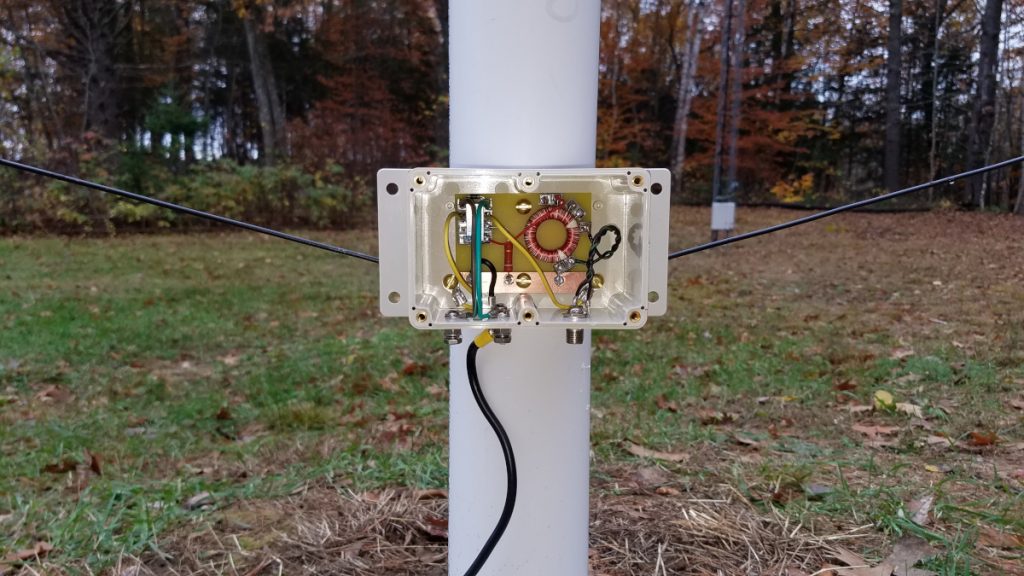
Over several weeks it became apparent the antenna’s performance was not stable. The pattern seemed to improve and worsen with environmental factors such as temperature and snow cover. Several other K9AY loop users suggested improving my ground system might help stabilize it but with snow already on the ground I decided that would not be practical until spring. I decided to modify the K9AY to use a vactrol instead of a fixed resistor for the termination. A vactrol is essentially a voltage variable resistor consisting of a LED and a photocell in a small four lead package. I obtained a VTL5C4 vactrol made by Xvive and installed it on the K9AY. Additional control conductors were run to the antenna so I could control the termination resistance remotely from the operating position. This change has thus far allowed achieving at least 17 dB front to back using sky wave signals as a reference on any given night. There have been times when I see more than 30 dB front to back on DX signals. I have no explanation for that, since the computer model suggested a maximum of 17.5 dB. Front to back often undergoes short term changes which I suspect are due to changing vertical arrival angle of signals, possibly with some contribution from skew path signals if that phenomenon exists on 2200 meters. Skew path is common on 160 meters. Termination resistance typically requires adjustment with major temperature changes and after significant snowfall events.
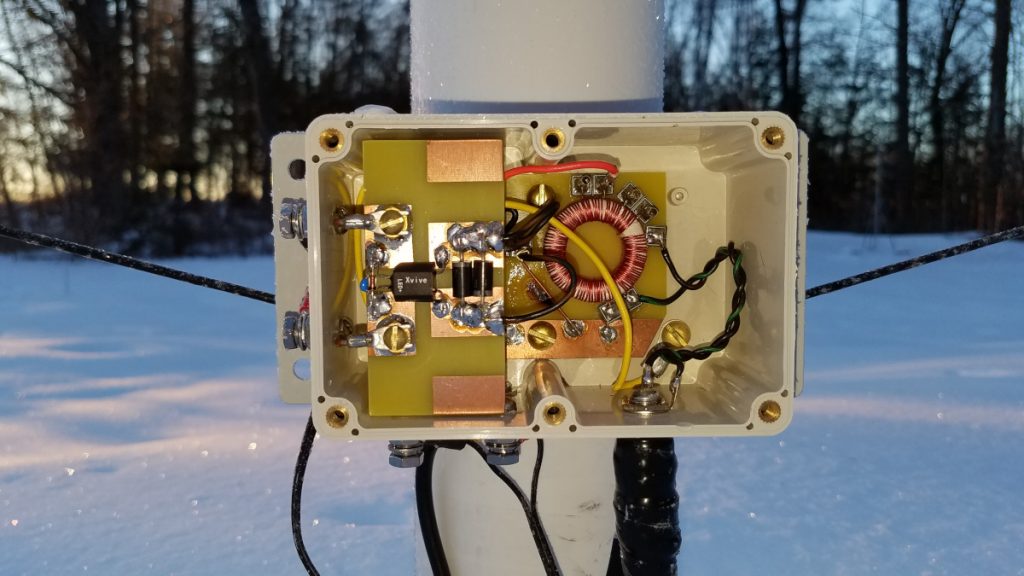
So, with those changes made, how does it work? Better than expected! I have been comparing antennas by listening simultaneously on both using identical receivers feeding identical sound interfaces on the same computer. I am using six instances of WSJT-X monitoring three modes: WSPR2, FST4W-120, and FST4W-1800. SNR as reported by WSJT-X is recorded for every signal received and each antenna it is received with. From that data, the following results have been extracted and calculated. The method is not perfect as there is uncertainty in the reported SNR, especially with weak signals near the decoding threshold. However it is the most practical method to get a reasonable comparison.
Before getting into the results, I should point out that having the new directional antenna has confirmed something I already suspected: I have more man made noise to the southwest/west than to the northeast/east. This means I get a bigger advantage from the K9AY loop when listening to signals from the northeast, which puts many of my local noise sources off the back. Any advantage when listening southwest is largely nullified by the fact that my local noise mostly comes from that direction. During the day, when atmospheric noise is not a factor, my noise floor increases between 2 and 5 dB in the southwest direction compared to northeast. In addition to this increase in the overall noise floor, a number of “interference lines” and some narrow smears can be seen.

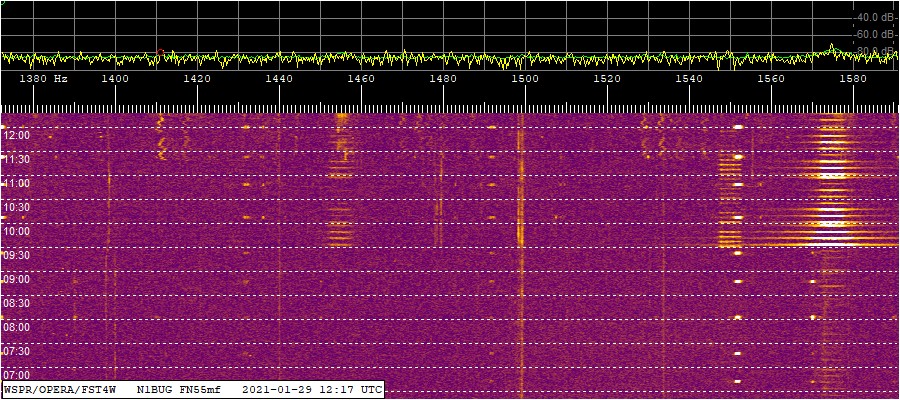
Results from the night of 22/23 January, 2021: With the K9AY loop listening northeast, a total of 35 transmissions from European stations were received. Of those, 21 were decoded only on the K9AY loop, while 14 were decoded both on the K9AY and the LNV. Of the latter 14, signal to noise ratio was always better on the K9AY, the improvement ranging between 3 and 7 dB for an average of 4.3 dB. While listening southwest, a total of 47 transmissions from stations in that general direction were received. Of those, 45 were decoded on both antennas with an average advantage of 0.3 dB to the K9AY. One transmission was decoded only using the LNV and one using only the K9AY.
Results from the night of 23/24 January, 2021: Listening northeast, a total of 56 transmissions from European stations were decoded; 25 only on the K9AY and 31 on both antennas. Of the 31, S/N ranged from 2 to 7 dB better on the K9AY for an average of 4.0 dB. Listening southwest, a total of 66 transmissions were received from stations in that direction; 62 on both antennas with an average advantage of 0.2 dB to the K9AY, 3 only on the LNV and 1 only on the K9AY.
Results from the night of 24/25 January, 2021: Listening northeast, a total of 89 transmissions from European stations were decoded, 45 only on the K9AY and 44 on both antennas. Of the 44, S/N ranged from 1 to 11 dB better on the K9AY for an average of 5.5 dB. The k9AY gained greater advantage later in the period. This may have been due in part to increasing static from storms over the central U.S. Listening southwest, a total of 12 transmissions were received from stations in that direction. All were decoded on both antennas with an average advantage of 0.3 dB to the K9AY.
Results from the night of 25/26 January, 2021: Listening northeast, a total of 17 transmissions from European stations were decoded; 7 only on the K9AY and 10 on both antennas. Of the 10, S/N ranged from 2 to 6 dB better on the K9AY for an average of 4.0 dB. Listening southwest, just one transmission was decoded, and only on the K9AY. However, it was a good one, AX4YB (VK4YB with a special prefix for Australia Day).
Results from the night of 26/27 January, 2021: Listening northeast, a total of 6 transmissions from European stations were decoded; 1 only on the K9AY and 5 on both antennas. Of the 5, S/N ranged from 1 to 5 dB better on the K9AY for an average of 3.6 dB. Listening southwest, a total of 18 transmissions were received from stations in that direction; all were received with both antennas with an average advantage of 0.3 dB to the LNV.
Results from the night of 27/28 January, 2021: Listening northeast, a total of 27 transmissions from European stations were decoded; 6 only on the K9AY and 21 on both antennas. Of the 21, S/N ranged from 2 to 6 dB better on the K9AY for an average of 2.8 dB. Listening southwest, a total of 49 transmissions were received from stations in that direction; 45 on both antennas with an average advantage of 0.4 dB to the K9AY, 1 only on the LNV and 3 only on the K9AY.
Results from the night of 28/29 January, 2021: On this night my local noise was somewhat lower than in previous nights, which may have contributed to slightly different results. Listening northeast, a total of 24 transmissions from European stations were decoded; 7 only on the K9AY, 1 only on the LNV and 16 on both antennas. Of the 16, S/N ranged from 0 to 4 dB better on the K9AY for an average of 2.3 dB. Listening southwest, a total of 47 transmissions were received from stations in that direction; 44 on both antennas with an average advantage of 0.6 dB to the K9AY, 3 only on the K9AY. VK4YB was received twice on each antenna, the first time with a 2 dB advantage to the K9AY and the second time equal on both antennas.
Results from the night of 29/30 January, 2021: Northeast there were a total of 21 transmissions from Europe decoded. Of the 10 captured on both antennas, S/N ranged from 2 to 4 dB better on the K9AY for an average of 2.7 dB. Southwest had a total of 38. 37 were received on both antennas with an average advantage of 0.1 dB to the K9AY. One was decoded only with the LNV.
Results from the night of 30/31 January: Northeast had a total of 8, four being heard with both antennas with S/N favoring the K9AY between 2 and 3 dB with an average of 2.7 dB. Southwest there were 40 in total, 36 being heard on both antennas with an average advantage of 0.4 dB to the K9AY. Two were heard only with the LNV and two only with the K9AY.
These results should be considered in the context of “what can I receive with one antenna that I cannot with the other” rather than “how many dB better is one antenna than the other”. Why? Because of the noise blanker settings I am using for the FST4W modes in WSJT-X. The way I have it set, it will first try to decode without any noise blanking. If that succeeds it will stop there. If not it will next try with a noise blanker setting of 5%. If that succeeds it will stop there. If not it will in turn try 10, 15, and 20% but it will stop at any point if a successful decode is obtained. What this means is that if on a given antenna it is able to decode a signal without using the noise blanker or with a low noise blanker level, it makes no attempt to see if it could get a better signal to noise ratio using more noise blanking. But when decoding on the “weaker” antenna it might get one or more levels deeper into noise blanking before obtaining a decode. This can have the effect of reducing the reported difference in S/N between the two antennas. During these tests I saw many cases where it decoded almost immediately on the K9AY but took longer on the LNV. This suggests on the LNV it was requiring more noise blanking to succeed, and that some of the decodes on that antenna might not have happened at all if I used no noise blanking or only one fixed setting. So if anything, the advantage of the K9AY is likely understated in these tests.
While not formally summarized in the above results, I have been paying attention to apparent front to back when receiving signals off the back of the K9AY. I say apparent because I am not switching the K9AY to the other direction but instead comparing the S/N ratio on the LNV to that of the K9AY. One some nights, apparent front to back is typically 10 to 15 dB with some values in the single digits. Other nights it ranges from single or low double digits to 24 dB or more. I suspect at times it is even more. For example I received a transmission from WH2XND at 0 dB S/N on the LNV but it did not decode at all off the back of the K9AY and could not be seen on any of my waterfalls, fast or slow! That would suggest something on the order of 30 dB difference between the two antennas.
The bottom line is that I am receiving a lot more European DX thanks to the K9AY loop. This antenna is well worth the work and expense that went into it.
Intermittent listening on 630 meters prior to the vactrol modification suggested an even bigger improvement northeast over the LNV on that band, though no formal comparison was made to to lack of a second receiver. On this band there may have been more advantage to the K9AY in the southwest direction but it was hard to tell with just one receiver.
